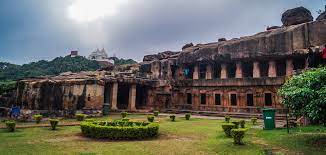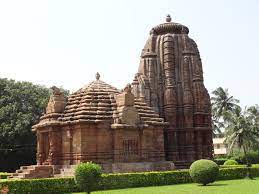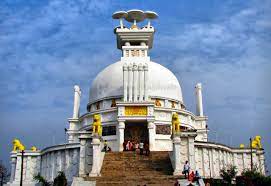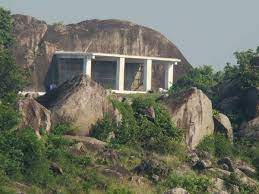Archaeological sites in odisha
Sun Temple, Konarak
Built in the thirteenth century, it was conceived as a gigantic solar chariot with twelve pairs of exquisitely-ornamented wheels dragged by seven rearing horses. The temple comprised a sanctum with a lofty (presumably over 68 m. high) sikhara, a jagamohana (30. m. square and 30. m. high) and a detached nata-mandira (hall of dance) in the same axis, besides numerous subsidiary shrines. The sanctum and the nata-mandira have lost their roof. The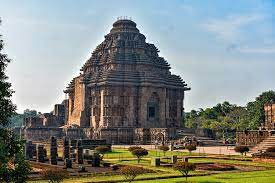
Udaigiri & Khandagiri Caves, Bhubaneswar
The twin hills Udayagiri and Khandagiri (Lat. 20.16 N; Long. 85.47E) are located in the vicinity of Bhubaneswar town. The National Highway No.5 passes through the close proximity of the hills. These two hills represent one of the earliest groups of Jaina rock-cut architecture in eastern India in the field of architecture, art and religion. These caves were first brought to the notice by A. Stirling in 1825 A.D.
Rising abruptly amidst a wide expanse of arid lateritic Soil both the hills separated from each other by a narrow row through which passes modern road between Bhubaneswar and Chandaka. The ancient names of the twin hills of Udayagiri and Khandagiri are Kumari and Kumara parvatas respectively. . There are total 33 rock cut caves on both the hills out of which 18 caves are excavated on Udayagiri hill while 15 are on the Khandagiri hill. Generally caves are single storied but a few of them are double storied also.
These hills are honeycombed with excavated rock-cut caves, essentially meant for the dwelling retreats of the Jaina recluses. On the basis of inscriptional evidences, these caves were first excavated by king Kharavela of Chedi dynasty and his successors who were devout Jainas during the first century B.C. The Jaina occupation was continued here with occasional breaks down to the present day. The Jain temple on the top of the Khandagiri hill was constructed in late 19th century is under worship even at present, preserving the continuity and tradition of the glorious past of the hill.
Rajarani Temple, Bhubaneswar
The Rajarani temple, Bhubaneswar in the district of Khurda is located towards north-east of Lingaraj temple is one of the most beautiful temples representing a unique experiment in the field of architecture in Orissa. The temple, in all Probability, referred to in the traditional Sanskrit texts as Indresvara Siva temple is remarkable for its sculptural excellence, profusion of ornaments, exuberant architectural features and multiple scroll work. At present, the sanctum is devoid of any deity. The present name Rajarani has been derived from a very fine grained yellowish sand stone called Rajarania in common parlance with which the entire edifice has been built. Mellowed by time, the glaring amber of the stone complements its architectural splendor.
The temple has panchanga bada or five divisions viz., pabhaga, talajangha, bandhana, uparajangha and baranda. The lowermost division is called pabhaga having five decorative mouldings namely, khura, kumbha, patta, kani and basanta. The superstructure (gandi) of the temple is distinguished by number of miniature turrets (angasikharas). The composite form of the temple with clustering of such miniature turrets, multiple recesses and angles make the edifice circular in appearance. Above the superstructure is crowned with a fluted disc shaped architectural members called amalaka. A vase (kalasa) surmounts the amalaka as the crowning finial.
Excavated Buddhist site, Laitagiri
Lalitgiri, locally known as Naltigiri in Birupa-Chitrotpala valley is one among the major centers of Buddhism-2/”>Buddhism in the Mahanga Tahsil of Cuttack district. It is 90 km. away from the state capital, Bhubaneswar. The site is couched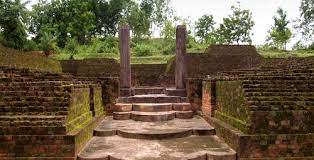
Dhauli, Odisha
Dhauli hills are located on the banks of the river Daya, 8 km south of Bhubaneswar in Odisha (India). It is a hill with vast open space adjoining it, and has major Edicts of Ashoka engraved on a mass of rock, by the side of the road leading to the summit of the hill.
Dhauli hill is presumed to be the area where the Kalinga War was fought. The Rock Edicts found here include Nos. I-X, XIV and two separate Kalinga Edicts.In Kalinga Edict VI, he expresses his concern for the “welfare of the whole world”. The rock-cut elephant above the Edicts is the earliest Buddhist sculpture of Odisha. The stone elephant shows the animal’s foreparts only, though it has a fine sense of form and movement.
Jaugada,odisha
Jaugada ruined fortress in the Ganjam district in Odisha, India. Jaugada lies 35 km north-west of Berhampur and 160 km south-west of Bhubaneshwar. Once a provincial Mauryan fortified capital of the newly conquered province of Kalinga, Jaugada is famed by its version of the monumental stone-cut edicts in Prakrit of the Mauryan emperor Ashoka.
Despite J.D. Beglar’s description during the later 19th century of the extant fortification towers and moat (“The walls had towers, also of earth, at each of the four corners, and also on each flank of each of the eight entrances”), without photos and drawings, the remains are difficult to visualize and comprehend. In 1956 Debala Mitra of the Archaeological Survey of India transected the northern glacis with a trench. The now collapsed trench of this investigation appears to lie just east of the eastern gate of the north wall. It is near the great Shiva temple Kaleswar & Rameswar (which is known as a temple where Shiva and Vishnu are seen together).,
Odisha is a state in eastern India that is home to a wealth of archaeological sites. These sites date back to a variety of periods, from the Indus Valley Civilization to The Gupta Empire. Some of the most important archaeological sites in Odisha include:
- Achutrajpur: This site is located in the Mayurbhanj district of Odisha. It is home to a number of temples and other monuments that date back to the 7th-10th centuries.
- Ahirpur: This site is located in the Sambalpur district of Odisha. It is home to a number of temples and other monuments that date back to the 6th-10th centuries.
- Asurgarh: This site is located in the Balangir district of Odisha. It is home to a number of temples and other monuments that date back to the 6th-10th centuries.
- Bhubaneswar: This is the capital of Odisha and is home to a number of important temples, including the Lingaraja Temple and the Jagannath Temple. These temples date back to the 10th-13th centuries.
- Chandipur: This is a beach town located in the Puri district of Odisha. It is home to a number of temples and other monuments that date back to the 7th-10th centuries.
- Dhauli: This is a hill located near Bhubaneswar. It is home to a number of Buddhist monuments, including the Dhauli Stupa and the Dhauli Rock Edicts. These monuments date back to the 3rd century BCE.
- Deulagarh: This site is located in the Keonjhar district of Odisha. It is home to a number of temples and other monuments that date back to the 6th-10th centuries.
- Dhauligiri: This is a hill located near Bhubaneswar. It is home to a number of Buddhist monuments, including the Dhauli Stupa and the Dhauli Rock Edicts. These monuments date back to the 3rd century BCE.
- Harichandanpur: This site is located in the Ganjam district of Odisha. It is home to a number of temples and other monuments that date back to the 7th-10th centuries.
- Jaugada: This site is located in the Ganjam district of Odisha. It is home to a number of temples and other monuments that date back to the 7th-10th centuries.
- Khiching: This site is located in the Mayurbhanj district of Odisha. It is home to a number of temples and other monuments that date back to the 7th-10th centuries.
- Lalitgiri: This site is located in the Kendrapara district of Odisha. It is one of the four sites that make up the Mahamegha Mounds. These sites are home to a number of Buddhist monuments that date back to the 2nd century BCE.
- Mangalagiri: This site is located near Bhubaneswar. It is home to a number of temples and other monuments that date back to the 7th-10th centuries.
- Ratnagiri: This site is located in the Cuttack district of Odisha. It is one of the four sites that make up the Mahamegha Mounds. These sites are home to a number of Buddhist monuments that date back to the 2nd century BCE.
- Sisupalgarh: This site is located near Bhubaneswar. It is an important archaeological site that dates back to the 3rd century BCE.
- Udayagiri: This site is located near Bhubaneswar. It is home to a number of Jain and Hindu temples that date back to the 6th-10th centuries.
- Vajragiri: This site is located near Bhubaneswar. It is home to a number of Jain and Hindu temples that date back to the 6th-10th centuries.
- Virajanagar: This site is located in the Kalahandi district of Odisha. It is home to a number of temples and other monuments that date back to the 11th-13th centuries.
These are just a few of the many archaeological sites that are located in Odisha. These sites provide a wealth of information about the history and culture of the region. They are a valuable resource for scholars and tourists alike.
Here are some frequently asked questions and short answers about archaeological sites:
What is an archaeological site?
An archaeological site is a place where people have lived or worked in the past. It can be a city, a village, a farm, or even a single building.What are some of the most important archaeological sites in the world?
Some of the most important archaeological sites in the world include the ancient city of Petra in Jordan, the ancient city of Machu Picchu in Peru, and the ancient city of Pompeii in Italy.What can we learn from archaeological sites?
Archaeological sites can teach us about the past in many ways. They can tell us about the people who lived there, what they did for a living, how they lived, and what their beliefs were.How are archaeological sites studied?
Archaeological sites are studied by archaeologists. Archaeologists use a variety of methods to study sites, including excavation, survey, and analysis.What are some of the challenges of studying archaeological sites?
One of the challenges of studying archaeological sites is that they can be very fragile. If they are not properly excavated and preserved, they can be destroyed.What are some of the ethical issues involved in studying archaeological sites?
One of the ethical issues involved in studying archaeological sites is the ownership of the artifacts that are found. It is important to respect the cultural heritage of the people who lived at the site.What are some of the benefits of studying archaeological sites?
The benefits of studying archaeological sites are many. They can help us to understand the past, learn about different cultures, and appreciate the beauty of the world around us.What are some of the ways that archaeological sites are used today?
Archaeological sites are used in many ways today. They can be used to educate the public about the past, to preserve cultural heritage, and to attract tourists.What are some of the threats to archaeological sites?
Some of the threats to archaeological sites include looting, development, and Climate change.What can we do to protect archaeological sites?
There are many things that we can do to protect archaeological sites. We can educate the public about the importance of archaeology, support archaeological research, and donate to organizations that protect archaeological sites.
Sure, here are some MCQs on the following topics:
- The Indus Valley Civilization
- The Harappan Civilization
- The Aryans
- The Mauryan Empire
- The Gupta Empire
- The Chola Empire
- The Vijayanagara Empire
- The Mughal Empire
- The British Raj
- The Indian Independence Movement
The Republic of India
The Indus Valley Civilization was located in:
(A) India
(B) Pakistan
(C) Afghanistan
(D) IranThe Harappan Civilization was a major urban civilization that flourished in the Indus Valley from about 2600 to 1900 BCE. It was one of the earliest civilizations in the world, and it was also one of the most advanced. The Harappans were skilled in agriculture, architecture, and engineering. They built large cities with well-planned streets and Drainage Systems. They also developed a system of writing that has not yet been deciphered.
The Aryans were a group of Indo-European people who migrated to India from Central Asia around 1500 BCE. They brought with them their own language, culture, and religion. The Aryans conquered the Indus Valley Civilization and established their own empire in India.
The Mauryan Empire was the largest and most powerful empire in India’s history. It was founded by Chandragupta Maurya in the 4th century BCE. The Mauryan Empire reached its peak under the reign of Ashoka the Great, who ruled from 272 to 232 BCE. Ashoka was a Buddhist ruler who promoted peace and non-violence. He is also known for his many public works projects, including the construction of roads, canals, and hospitals.
The Gupta Empire was a golden age in Indian history. It was founded by Chandra Gupta I in the 4th century CE. The Gupta Empire reached its peak under the reign of Samudragupta, who ruled from 335 to 375 CE. Samudragupta was a powerful warrior who conquered many kingdoms in India. He is also known for his patronage of the arts and sciences.
The Chola Empire was a powerful empire that ruled southern India from the 9th to the 13th centuries CE. Cholas/”>The Cholas were skilled in maritime trade and naval warfare. They conquered many kingdoms in Southeast Asia and established a large empire.
The Vijayanagara Empire was a powerful empire that ruled southern India from the 14th to the 16th centuries CE. The Vijayanagara Empire was founded by Harihara I and Bukka Raya I in 1336 CE. The Vijayanagara Empire reached its peak under the reign of Krishnadevaraya, who ruled from 1509 to 1529 CE. Krishnadevaraya was a powerful warrior and a patron of the arts and sciences.
The Mughal Empire was a powerful empire that ruled northern India from the 16th to the 18th centuries CE. The Mughal Empire was founded by Babur in 1526 CE. The Mughal Empire reached its peak under the reign of Akbar the Great, who ruled from 1556 to 1605 CE. Akbar was a powerful warrior and a wise ruler. He is also known for his religious Tolerance.
The British Raj was the period of British rule in India from 1858 to 1947. The British Raj began with the Indian Rebellion of 1857, also known as the Sepoy Mutiny. The British Raj ended with the Indian Independence Act of 1947, which granted India independence from British rule.
The Indian Independence Movement was a movement that sought to end British rule in India. The Indian Independence Movement began in the late 19th century and culminated in the Indian Independence Act of 1947, which granted India independence from British rule.
The Republic of India is a country in South Asia. It is the world’s second-most populous country, with over 1.3 billion people. India is a federal republic with 28 states and 7 union territories. The capital of India is New Delhi.
I hope these MCQs were helpful!
